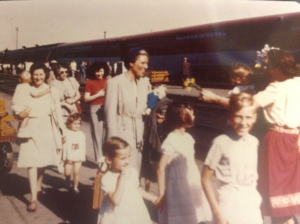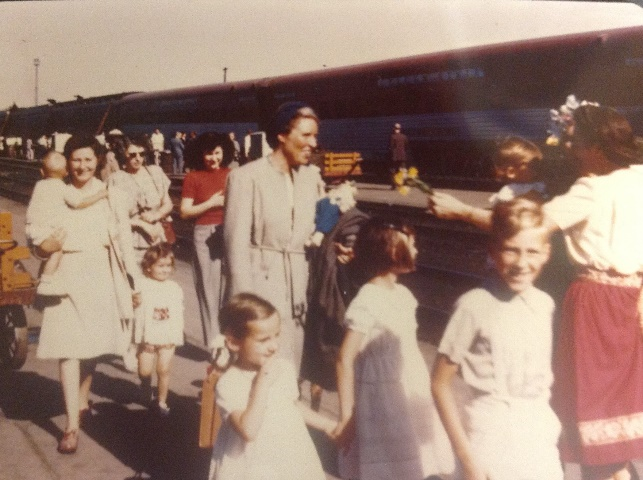When Nazi Wives Came to El Paso by Jonna Perrillo

Figure 1: Paperclip wives arriving in El Paso, Texas, 1947. Photo courtesy of Ernst Steinhoff Papers, New Mexico State University Library.
Boarding a Pullman train car in 1947 that would take her and her children from New York City to El Paso, Texas, Ursula Haukohl noticed that her last name was misspelled on her ticket. Yet when she mentioned this to one of the railway workers she was told, “Oh lady, that doesn’t matter. When you are in America you can call yourself whatever you want. Important is only that your husband loves you.” So Haukohl recounted the exchange in a letter to her parents in Germany.[1] Her husband was one of 178 scientists who had built the V-2 missile for the Third Reich and, through Operation Paperclip, was recruited to build missiles for the U.S. Army in the earliest days of the Cold War. The scientists and their families were quickly stationed at Fort Bliss, where they would live in shared barracks for over three years. Having set foot in the United States only a day or two before her train trip, Ursula Haukohl was already receiving some of her first lessons in being a woman in America.
Many El Pasoans have heard of the Paperclip scientists’ presence here and in Huntsville, Alabama, where most of the team would move in 1950. Under Wernher von Braun’s leadership, they would develop the American space program and become national heroes, their Nazi pasts overwritten by their great achievements for American science. But few stop to consider their families who immigrated with them. Aspects of the wives’ personal histories are documented in collections at the National Archives in College Park, Maryland. As with some of the scientists, their participation in Nazi organizations was recorded but ignored. From Operation Paperclip’s beginning, the women’s value to U.S. military officials was in improving the image of their husbands by serving as doting wives and mothers. In so doing, they would help their families to appear less fascist and more potentially American. Their success at this would help the controversial Operation Paperclip to survive.
In my forthcoming book Educating the Enemy: Teaching Nazis and Mexicans in the Cold War Borderlands (University of Chicago Press), I examine what the Paperclip children’s experiences in El Paso schools can teach us about race, schools, and American democracy. But the Paperclip women illuminate further aspects of American political culture. The 103 wives were by no means uniform: while over half were 25 to 35 years old and mothered preschool or elementary school-aged children, they possessed varying amounts of education, class identities, and lifestyles before they came to the United States. A few spoke fluent English, many spoke none. These differences could create tensions between the women, who spent much of their time together once here in El Paso.
Yet collectively, Nazism had disenfranchised them through its rhetoric of Kinder, Küche, Kirche (children, kitchen, church). Much like the ideas of womanhood in Cold War America, “good women” in Nazi Germany were measured by their dedication to their families, to their churches, and to the nation. For some of the women, according to their children, Nazism disrupted their careers and dreams even as it built those of their husbands. In this sense, they profited, economically and in some ways socially, from the same system that oppressed them. In El Paso, the press highlighted their participation in local churches and P.T.A.s and recorded how the women “generously circulated” through El Paso society. The Paperclip women’s experiences show how the social expectations that they encountered throughout their lives, on two continents, remained more consistent than not.
Not surprisingly, their children remember their mothers in loving but more multifaceted terms. Ursula (Mrazek) Vann remembers that her mother “bartered and begged” for food from shopkeepers to keep her family fed in the days after the war. Helga (Minning) McGhee recalls her mother hiding their family’s most valuable possessions in a town church, only for the church to be bombed. Ilse Axster was a Montessori teacher turned Nazi servant who in 1947 briefly secured an offer to teach German at the Radford School (the offer was rescinded because of her publicly documented work for the Third Reich). The women of Operation Paperclip proved to be well-skilled beyond household management, but all of these intricacies would be erased by their one-dimensional public image as good wives and mothers.
None of the women in the Paperclip group were of the violent type of Nazi that Wendy Lower exposes in her book Hitler’s Furies: German Women in the Nazi Killing Fields (though Axster was accused of violence and abuse against foreign workers during the war). But some, likely many, shared fascist beliefs that many German women possessed. We cannot fully know what the Paperclip women thought, or what they did, in part because Americans did not ask. American military and diplomatic officials, and journalists, heard what they wanted to hear—and made the women into the women they wanted them to be—in order to support Cold War military campaigns and a growing military industrial complex. Our national security, they contended, hinged on being able to retain “Hitler’s pets” to work for the U.S.. In the time before the scientists could develop American missiles and prove their own worth, their families were paramount to their public image. In this sense, then, the Paperclip women can instruct us in more than social expectations for women during the Cold War. They reveal in new fashion just how much our society and our government had invested in those expectations.
Jonna Perrillo is an education historian and associate professor of English Education at the University of Texas at El Paso. Her book on the Paperclip children will be published in December. She can be reached at jperrillo@utep.edu.
[1] Interview with Juergen Haukohl, Apollo 11 Legacies podcast (WHNT News 19), S E14: “Paperclip Family Legacies,” aired August 28, 2019

